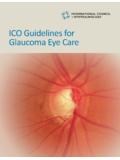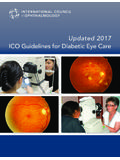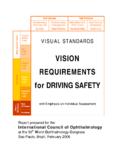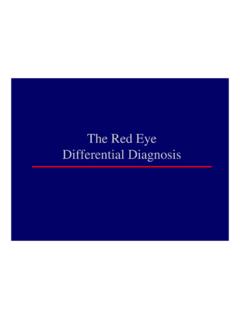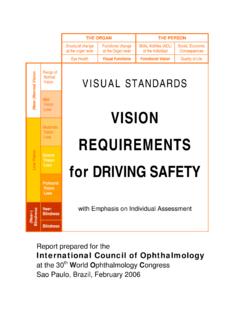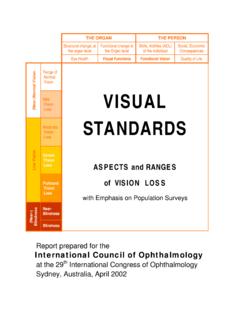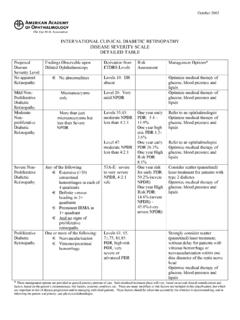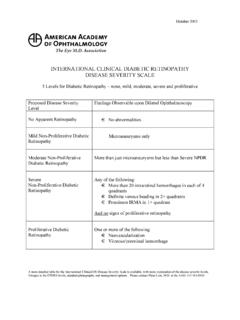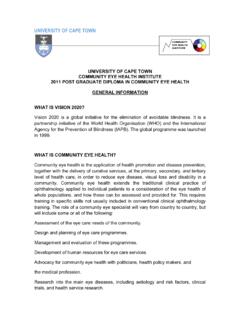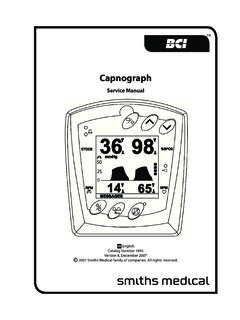Transcription of public health and cataract coments.ppt
1 public health and cataract blindness Overview This presentation covers the following topics: Definitions Epidemiology of cataract public health approaches to control cataract blindness Conclusion Notes section a more detailed explanation is provided in the notes along with key references. Definition and classification of cataract Definition : Abnormal morphology Decreased light transmission Decreased visual acuity Aetiology: Age related Congenital Traumatic Secondary Location of the opacity: Cortical Nuclear Posterior subcapsular cataract grading systems WHO simplified grading rapid method designed for surveys undilated pupil very good interobserver agreement LOCSS photographic method Used in case control studies/cross sectional surveys dilated pupil very good interobserver agreement Magnitude.
2 Prevalence of cataract Study and location Sample Ye a rs Nuclear Cortical PSC Beaver Dam USA 1988 90 4926 55 64 65 74 75 84 Blue Mountains Australia 1992 94 3654 55 64 65 74 75 84 South West, Nigeria 2006 07 1031 50 59 60 69 70+ All 50+ INDIEYE: 2 centres 2007 08 5871 60+ Magnitude: prevalence of cataract blindness Prevalence data from: surveys population based assessment methods in adult s over 50 years of age In general: 50% of all causes of blindness 18 million cataract blind Higher prevalence in developing countries cataract risk factors Non modifiable Age Female gender Genetics Modifiable: Smoking Diabetes Steroids Chronic UV exposure MJC1I3 Slide 7 MJC1 Technically this is modifiable but for some patients on long-term administration it's hard to find an Carter, 6/2/2011I3 Agree, this point is discussed on the subtext on the primary prevention have also included it below for further , 7/5/2011 Management of cataract : surgery MSICS.
3 Technique of choice in developing countries Phacoemulsification: technique of choice in developed countries Technique Phaco MSICS Visual outcome Same at 6 weeks postop. Operating Time Longer Shorter Cost Expensive Cheaper Training Difficult for ECCE surgeons. Easier for ECCE surgeons public health strategies for cataract Primary prevention: prevent cataract from forming Secondary prevention: prevent progression to cataract blindness in patients with cataract Te r t i a r y prevention: treat the cataract blind Primary prevention of cataract health education orientated to modify risk factors which may only delay the development but not prevent it.
4 Smoking: cessation campaigns Diabetes: tight control of blood sugar Steroids: avoid long term treatments if possible UV exposure: use sunglasses and hats Secondary prevention of cataract Surgery in patients before they are blind from cataract : awareness campaigns early surgery is routine in developed countries in developing countries priority to operate on the cataract blind? Improving accessibility and affordability of services Tertiary prevention : surgery to restore sight in blind eyes cataract surgery control strategies: output: quantity how many operations done and in how many blind patients?
5 Outcome: quality what are the results and how do we monitor them? outlay: cost what is the cost/cost effectiveness? MJC2I5 Slide 12 MJC2 Just a note that compared to other slides, in the notes section there are no comments on points 2 and 3 Marissa Carter, 6/2/2011I5 This slide is just an outline of what is discussed in the following ones. No much point on repeating what will be said later, but the smallparagraph and references will hopefully aid students structure , 7/5/2011 Schematic view of the cataract Burden Backlog number of cataract cases not operated in a given population.
6 Backlog can be defined for blindness, or an agreed operable visual acuity cutoff Back log + received surgery = burden of cataract Incidence number of new cases developing cataract / year CSR cataract surgical rate surgeries / million / yearMJC3I2 Slide 13 MJC3 Notes: "In many developed countries this can be at even at 6 " Is this a typo? Maybe 6/60? Really should be 6/18 or 20 Carter, 6/2/2011I2 Not a typho: refering to the fact tha in developed countries patients can get cataract surgery as soon as they are symptomatic, despiteof very good visual acuity when measured.
7 6/6 is probably not so common, I have changed to 6/9 which is not an uncommon scenarioin the UK and ammended the comments to make them a bit clearerITD, 7/5/2011 cataract Output: cataract surgical rate CSR: performance indicator number of surgeries performed per million population per year Minimum CSR must be equal to the incidence of operable cataract , but consider that not all operated eyes are blind Must include all sectors: private/ public /NGO Caution when comparing across regions as prevalence and incidence of disease varies. MJCS lide 14 MJC4 in the Notes section: "It simply indicates the extent of the efforts to control cataract blindness in a particular region.
8 (1)" This may have been what the authors said but I strongly disagree. CSR and blindness due to cataract do not correlate!Marissa Carter, 6/2/2011I6 I have refrased this, to account for the fact that most patients are probably not blind preop. Hope it is clearer this way?ITD, 7/5/2011 CSR world map 2006 cataract Output: cataract surgical coverage CSC: impact indicator: proportion of operable cataract cases operated at a point in time. survey data CSC for persons proportion of people, with bilateral operable cataract that have had surgery in one or both eyes at a point in time.
9 CSC for eyes proportion of eyes that received surgery at a point in time. It relates more to the total surgical workload for the ophthalmologists. If CSC eyes > than CSC person likely that bilateral surgery was done ideal CSC should be about 85% and more MJC6I7 Slide 16 MJC6 Not quite true; also depends on how CSC is calculated at what visual acuity Carter, 6/2/2011I7 ClarifiedITD, 7/5/2011 cataract surgical coverage CSC(persons)(VA)= x+y / x+y+z x100 X= number of persons with unilateral pseudoaphakia and operable cataract in the other eye Y= number of persons with bilateral pseudoaphakia Z= number of persons with bilateral operable cataract CSC(eyes)(VA)
10 = a / a+b x100 A = pseudoaphakic eyes b = eyes with operable cataract The larger the difference between CSC persons and CSC eyes, the greater the preference that has been given to operate on first eyes above second eyes. cataract outcome The change in functional disability as a result of cataract operation. Indicators: Visual outcome: visual acuity Visual functioning: impact of vision in activities of daily life * Quality of life: well being, mobility, mental outlook* WHO cataract outcome guidelines Postoperative acuity Available correction Best correction Good(6/6 6/18) >80% >90% Borderline (<6/18 6/60) <15% <5% Poor(<6/60) <5% <5% Additional guidelines: >90% should be IOL surgery Surgical complications <10%: capsular rupture <5% and vitreous loss <5% Causes of poor outcome Selection: patient related risk factors Surgery.

